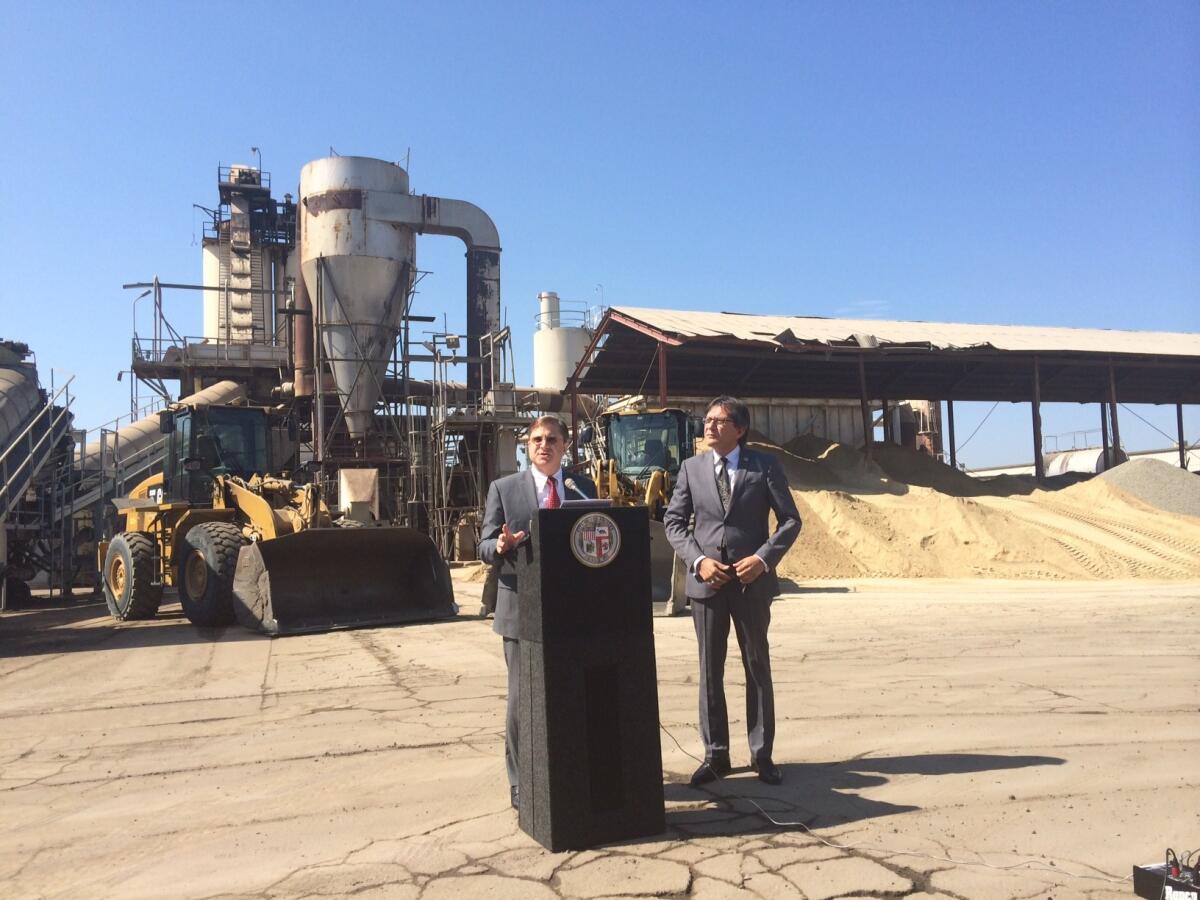Audit exposes management failures at L.A.’s Bureau of Street Services

A new audit found that the city agency charged with fixing and maintaining Los Angeles’ streets is beset with problems, including failing to collect or spend hundreds of millions of dollars that could be used to patch roads, keeping shoddy records and neglecting to put busy and heavily trafficked roads first.
“Los Angeles needs to invest in its streets, but before we allocate additional funds to the Bureau of Street Services, it must reform its management processes, adopt new oversight procedures and implement new technologies,” City Controller Ron Galperin wrote in a Times commentary column.
------------
FOR THE RECORD
An earlier version of this post reported that city plants can produce 60,000 tons of asphalt annually. The plants can produce 600,000 tons of asphalt a year.
------------
The woes of Los Angeles’ streets are already obvious to anyone on wheels or foot: Streets so pockmarked or broken that the city gives them a D or F grade make up roughly 40% of L.A. roadways. Better-off streets can be patched with slurry seal, but the worst are left to get even worse, rarely repaved or reconstructed, the audit found. The average grade for city streets is a C-minus, according to the bureau.
Fixing all those ailing roads would cost billions, according to estimates. But city auditors pointed out a host of problems with the way the Bureau of Street Services, part of the Department of Public Works, uses the money it already has -- a finding that could make it much harder for city officials to ask taxpayers to pony up more.
“Right now, people want to know with a sense of confidence that the money that we are spending is being properly spent,” Galperin said Thursday at a news conference announcing the audit’s findings. “And until that happens, I think people are going to be very reluctant -- and correctly so -- to say, ‘Let’s just throw more money at it.’”
Street Services Director Nazario Sauceda joined Galperin at the news conference outside a city asphalt plant off Olympic Boulevard downtown and promised to review the findings and take any necessary action.
“We take this audit very seriously,” he said.
Sauceda declined to answer questions about specific findings in the audit, saying he still had to review the final report. The director said he was proud of his department, which he said had undergone a 40% staff reduction over the last five years.
“We’re doing more today and we’re doing it more efficiently than ever before,” he said.
Auditors found that the Bureau of Street Services has been paying steeper prices to make its own asphalt than it would if the city just bought asphalt from an outside vendor.
City asphalt plants produce as much as 600,000 tons annually and provide more than a third of the material used to fix city streets. The city currently pays nearly $66 per ton to produce its own asphalt, while outside vendors can provide it for less than $40 per ton, according to the audit.
Sauceda explained that old equipment was unable to recycle as much old pavement as new ones, accounting for the difference in cost. The city plant where Galperin and Sauceda announced the audit would need nearly $18 million in upgrades to be able to produce asphalt at costs comparable to vendors’, according to the controller’s office.
Meanwhile, the bureau failed to collect money that could have gone to mend streets: Because of a failure to properly calculate fees, the bureau never collected $190 million from utility companies that cut into streets to replace water or electric lines, the audit found. That sum includes all money left uncollected since the fee was initiated in 1998.
Galperin said it was unclear how much of the uncollected $190 million was recoverable, saying it was a question for the city attorney to examine.
In addition, $21 million that was supposed to fund street repairs was left unspent between 2010 and 2013 -- which meant it was returned without being used, the report said. The unused funds included federal stimulus dollars.
“When a lack of funding is cited as the primary reason why only a limited number of streets can be repaired, [the bureau] should not be in a situation where budgeted funds are left unused,” the audit stated.
The audit also found systemic problems with the way the bureau operates.
Galperin wrote that “a great deal of information about the bureau’s activities is incomplete or simply missing,” with scant records to show how many potholes it had filled. Completion reports or work evaluations were missing for 60% of street paving projects, the report said.
Galperin also said that street officials did not consider traffic volume or heavy vehicle loads when prioritizing road repairs, instead relying on pavement condition. That left some of the most important and heavily trafficked streets in the worst shape, according to the audit.
Auditors wrote that the city could be missing an opportunity to provide the greatest benefit to the public, and neglecting streets that were more likely to degrade -- setting themselves up for more expensive repairs in the future.
The report focused on the period from 2010 to 2013, just before Mayor Eric Garcetti took office. The mayor’s office has worked with Street Services to improve its performance, including the repaving of 2,200 lane miles in the last year, Garcetti said in a statement. The bureau has also created the Neighborhood Blitz program to prioritize street repairs based on community comments, he said.
“I am committed to a back-to-basics agenda to reform City Hall so we can deliver better road repair and other critical services,” Garcetti said.
Auditors also questioned whether the bureau had good ways to seek out new technology to save time and money. At the news conference, Galperin said new software and hardware could help the bureau better track street conditions and manage its work. If the city invested in that technology, street services could be run more efficiently, he said.
Sauceda said the department currently uses a “state-of-the-art” system to assess street conditions. But Galperin said that the collection of information can take so long that it may be outdated by the time it is used.
“Just analyzing the condition of the pavement isn’t enough,” Galperin said, adding that the bureau needed to take into account how important each street is.
The report spotlighted a piece of equipment that Street Services had abandoned -- a “Pothole Killer” that allows a single worker to patch potholes faster and cheaper than a team hoisting shovels, according to the report.
More than a decade ago the bureau leased the machine with an option to buy it at zero cost, but stopped using it because of logistical problems. The bureau also claimed it was designed for use in cold weather, but the audit said it had been used in Sao Paulo, Brazil, ahead of the World Cup.
Earlier this year, Los Angeles lawmakers abandoned the idea of seeking a sales tax increase to repair streets and sidewalks, leaving it unclear how they would pay for a vast backlog of fixes. Garcetti postponed any decision on taxing residents for the rest of the year, saying the city needed to show that it was exploring alternatives first.
City Councilman Joe Buscaino, who is chairman of the council’s public works committee, said in a statement that he would work with the controller to “transform the Bureau of Street Services into the modern, efficient and innovative public works agency that this city deserves.”
Galperin said his office planned to revisit Street Services in a year to see what changes have been made and assess its performance.
Follow @latimesemily for what’s happening at Los Angeles City Hall.
More to Read
Start your day right
Sign up for Essential California for news, features and recommendations from the L.A. Times and beyond in your inbox six days a week.
You may occasionally receive promotional content from the Los Angeles Times.







